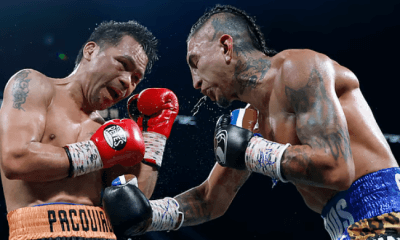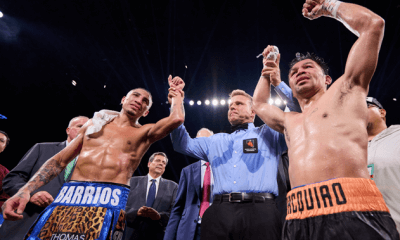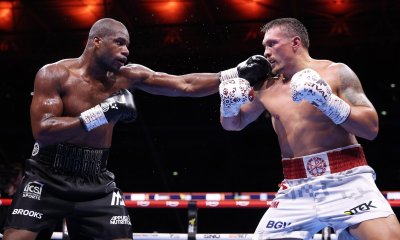Articles of 2005
Harold Johnson Preferred Style to Savagery
In a career that spanned 25 years and 88 pro fights, Harold Johnson fought the best fighters in two weight classes. He fought all over the world and never ducked an opponent. He fought five fellow Hall of Famers, including Archie Moore five times.
Yet Johnson, a light heavyweight champion and Hall of Famer, is somehow overlooked when people talk about Moore, Bob Foster and Michael Spinks as that division’s elite.
“It was just unfortunate that he came along the same time as Archie Moore did, who is the best light heavyweight ever,” said the Philadelphia-based Hall-of-Fame promoter Russell Peltz. “I think it hurts him that he only beat Moore once in those five fights. I saw Harold fight in person three times. He’s certainly one of the 10 greatest light heavyweights of all time.”
Johnson was one of the best technical boxers of his day. While he did not pack the same power as Moore, he was an outstanding boxer. Philadelphia may be known for its warriors, but Johnson may be the best pure boxer to emerge from the City of Brotherly Love. Johnson was an artist in a sport that usually appreciates savagery over style.
“I learned a lot from him,” said former light heavyweight contender Johnny Persol, who decisioned Johnson at the Garden in 1966. “My youth and my speed made me a winner. Harold Johnson knew all the tricks. He was a very good boxer. I started to really believe in myself after that. That’s when I came of age.”
Johnson still resides in Philadelphia. While at 76 years old he doesn’t recall all the details of his fabulous career, he remains a delightful man who welcomes conversation.
“My father, Phil Johnson, was a boxer. My brother boxed too, but not pro,” he said, recalling the days on how he got started in boxing. “I played baseball and I played tackle football up in Manayunk, in Germantown, that’s where I grew up. Where I lived, they called it the Scratch House. It wasn’t a very big place.
“I started boxing at the North Lake Boys Club. I think I was about eight years old. The guy who ran the gym used to be a boxer and he remembered my father. The first time I boxed, he looked at me and said, ‘Where did you learn how to fight like that?’ I didn’t know what he meant, I thought I did something wrong. I thought I was fighting dirty or something. Then he said, ‘You looked good.’
Johnson turned pro in 1946 and won his first 24 bouts before dropping a 10-round decision to Moore in 1949.
“I had to do something to help the house,” said Johnson. “My mother had this little stick-pin job, my brother had a job. My father was away somewhere and he wasn’t helping us. I figured boxing was the quickest way to make some money. I turned pro at 16. I had to raise my age up so they would let me fight.”
After his first defeat, over the course of the next four years, Johnson bested Jimmy Bivins, Bob Satterfield, Nino Valdes and Ezzard Charles. He also, in a three-month stretch from September of 1951 to January of 1952, fought Moore three times, winning the middle bout.
Finally, on August 11, 1954, he would challenge Moore for the light heavyweight title at Madison Square Garden. He dropped Moore in the 10th and was ahead on the scorecards when Moore scored a miraculous TKO in the 14th round.
Johnson wouldn’t challenge for the title again until 1961, when he beat Jesse Bowdry for the NBA crown. He unified the 175-pound division a year later by decisioning Doug Jones in Philadelphia. He made one successful title defense – against Germany’s Gustav Scholz – before losing the title in 1962 to Willie Pastrano.
“Aside from the night he beat Doug Jones for the title, I think his two greatest victories are against Gustav Scholz and Eddie Cotton,” said Peltz. “He beat Scholz in a soccer stadium in Berlin before 40,000 people. The referee and two judges were from Europe. That just doesn’t happen. Schultz was no walk in the park. In one of his NBA title defenses, he beat Eddie Cotton, in Seattle. Again, he got the decision in the other guy’s hometown. I don’t know that Schultz or Cotton will make the Hall of Fame, but they were outstanding light heavyweights.
“You just don’t get decisions like that today. Guys wouldn’t take those fights today. Harold was never really protected. If he had the right connections, he wouldn’t of even had 11 career losses.”
Johnson, whose record stands at 76-11, with 32 knockouts and 1 no contest, retired in 1968 while in the midst of a five-bout winning streak. He made a comeback in 1971, but was stopped on cuts by Herschel Jacobs.
“The biggest thrill I got wasn’t when I won the championship,” said Johnson. “It was always a great pleasure to see that smile on my mother’s face when I handed over all those hundred dollar bills after a big fight.”
-

 Featured Articles3 weeks ago
Featured Articles3 weeks agoThe Hauser Report: Zayas-Garcia, Pacquiao, Usyk, and the NYSAC
-

 Featured Articles2 weeks ago
Featured Articles2 weeks agoOscar Duarte and Regis Prograis Prevail on an Action-Packed Fight Card in Chicago
-

 Featured Articles2 weeks ago
Featured Articles2 weeks agoThe Hauser Report: Cinematic and Literary Notes
-

 Book Review7 days ago
Book Review7 days agoMark Kriegel’s New Book About Mike Tyson is a Must-Read
-

 Featured Articles4 weeks ago
Featured Articles4 weeks agoManny Pacquiao and Mario Barrios Fight to a Draw; Fundora stops Tim Tszyu
-

 Featured Articles4 weeks ago
Featured Articles4 weeks agoArne’s Almanac: Pacquiao-Barrios Redux
-

 Featured Articles3 weeks ago
Featured Articles3 weeks agoRemembering Dwight Muhammad Qawi (1953-2025) and his Triumphant Return to Prison
-

 Featured Articles4 weeks ago
Featured Articles4 weeks agoOleksandr Usyk Continues to Amaze; KOs Daniel Dubois in 5 One-Sided Rounds















